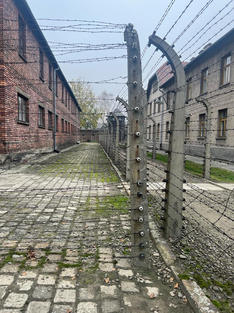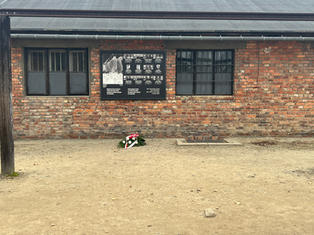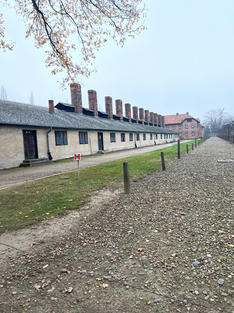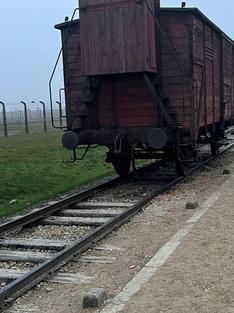University
Overview
In 2022-2023, I was pleased to facilitate and support guided trips to Auschwitz-Birkenau (Poland) for two groups of BA Creative Writing and Journalism students from Middlesex University, as part of the ‘Lessons from Auschwitz’ Universities Project, under the auspices of the Holocaust Education Trust (HET).
The wider aim of the trip, which included pre- and post-briefing sessions as well as the opportunity to listen to a survivor’s testimony, was to help understand and combat contemporary antisemitism. The participants came from Universities across the UK. Three of our students participated in the finale event for the 2023 Barnet Multi Faith Forum’s Faith and Peace Walk.
Monna Rizvi, Co-Chair Middlesex University Inter Faith Network (MDX IFN), had this to say about their involvement:
“The Middlesex University Inter Faith Network and Barnet Multi Faith Forum’s Faith and Peace Walk is a great opportunity for people of all faiths and none to come together and engage in meaningful and informal conversation. Learning from each other and reflecting on the similarities of our faiths which define us as human beings first and foremost. The finale event at the Grove, Middlesex University, mirrored the diversity of the walkers and including Sete Cohen, Roshanak Rafiei and Lolita Parekh who shared their images and amazing experience of visiting Auschwitz earlier in the year certainly added to the programme and gave the audience an insight as well as an opportunity to reflect further on human behaviour and the lessons we can learn from history.”
Sete and Roshanak visited in Autumn 2022, and Lolita was part of a group whom I accompanied in May 2023. Sete and Lolita both spoke at the finale, linking their experiences at Auschwitz to the theme of architecture and space, which was a feature of the peace walk, whilst Roshanak shared visual material she had recorded on her trip. There was a strong positive response to their presentations, and we agreed it would be helpful to create a space to record and share this material for anyone who might be interested. This CREW HQ website, which showcases the diversity and creativity of Middlesex University’s students and faculty, seemed the ideal space.
I was moved by the thoughtfulness and engagement of our students, and hope that their writing will open up new ways of being and seeing for all who visit CREW HQ. Please see their work below.
Warmly,
Ariel Kahn, Programme Leader, BA in Creative Writing and Journalism



Images from Auschwitz-Birkenau
Sete Cohen’s speech at the finale
My name is Sete, a creative writing and journalism student at Middlesex University, which I represented when recently visiting Auschwitz-Birkenau concentration death and work camps in Poland... with my colleague Roshanak.
Roshanak and I are from different cultures. The Auschwitz experience touched our humanity with individual and joint moments of sadness and enlightenment.
We saw the buildings which housed the machinery of death during the Holocaust and we saw the evidence of the genocide committed against human beings, whose only crime was their ethnicity, religion or race.
As we learn the lessons through the lens of history, we must carry on the legacy of truth through the generations, as Antisemitism, Racism and all forms of Discrimination, have no place in our civilised society.
Let us embrace our differences as well as our similarities, standing together to say, "Never again."
Significantly, the Architects of the buildings were people like you and me. Topf and Sons competed for the role to facilitate the Holocaust, in return for wealth. These were the Architects of the killing machines which filled the camps.
Their name is stamped in iron: on the crematorium ovens; on the ventilation systems; and on the gas chambers. Then to hide the shame, they helped to conceal the genocide via the ovens under their trademark, created for the disposal of bodies.
These were willing collaborators with free will and minds of their own... as educated company directors, engineers, oven fitters and ventilation experts, to name but a few trades for everyday living in normal society.
As I walked from place to place, I tried (and perhaps failed) to imagine what it must have been like and sensed an almost parallel world in place and time: imagining the human cargo, in packed trains, arriving at the end of the line, which was the final destination, to the mass grave of inhumanity and degradation.
As my night fell, darkness spread over Auschwitz and the temperature dropped, I felt a strange sense of connection with the earth. I subsequently read the book Night by one of the Auschwitz Survivors, Elie Weisel, with whom I seemed to connect through powerful spiritual impact.
I thought to myself, if we are to prevail in our mission to promote peace and understanding among all the cultures of the world, it is important to understand and recognise the signs and patterns of behaviour, through the empathetic lens of history. Then with conviction, we can truly say, "Never again." This will be our final solution.
The Auschwitz experience was spiritual as well as educational. I seemed to connect with the individuals of the past rather than focus on the total numbers who perished. Even the objects told a story. It was as if the event in history had frozen in time and lives on in this place… in a supernatural realm in eternal and loving memory.
Guided by an everlasting flame of goodness, through the corridors of time, the souls rise up in testimony. Through their eyes we see and through Auschwitz we witness. Taking a moment to reflect, we can measure our own lives and perceived problems within its context. The overwhelming darkness fades with a strong glimmer of hope for the future, generating our humanity and awakening the inner strength which we all possess.
Lolita Parekh’s speech at the finale
The walls weren’t made of titanium or tungsten. Those are apparently the strongest metals on Earth, according to Google. The fences weren’t electrified, and there weren’t any holding cells, not individual ones like we see in prisons. There were no iron bars on the doors, but wait, maybe there was some on the windows.
In another context, those buildings would just be that: buildings. They wouldn’t hold a chokehold on visitors like us, who walked up those stairs in silence, horrifyingly mesmerised by the noticeable wear of each step as we got to the first floors of the barracks.
In another world, we might look at the whole camp’s organisation with an approving nod, because it takes a lot of planning and intelligence to create such a system. That alone should tell us a lot…
I still think about those stairs, about the rows of red brick buildings and that train track – you know, the one that’s so famous in the movies. I remember our group’s silence, which held a thousand screams and fears and pains.
I visited Auschwitz to reinforce my knowledge of the Holocaust, of what I’d learnt at school and read in books since then. I wanted answers to questions I’d asked myself when I’d watched movies where words like ‘fascism’ and ‘nazi’ were thrown in here and there for it to feel accurate.
I left with more questions and not really any answers. I left with a bit less hope for humanity, because I wondered where humankind went during that horrible time of our history. I know some people said ‘what about’ slavery and other atrocities lived by other cultures, other histories that I’ve not learnt about or that I don’t know enough about to discuss safely. I don’t know about those other ‘what abouts’ but I do hope that we can all do our bit so that we can learn and not repeat history. I am talking here today because I want to believe in the good we can do, because I want to have hope for humanity.
Roshanak Rafiei’s video from Auschwitz-Birkenau
‘Train of Thought’, by Sete Cohen
There is a mystical place where only I can go, as my mind runs wild with anticipation. My arm reached out to touch the rising spirit of Auschwitz. So many untold stories of those who fell into the mass grave of silent oppression. My trip to the concentration death and work camps opened up a route for me into the horrors of the past through spiritual impact. Since then, I have been inspired to write about the Holocaust from various angles and perspectives, as my imagination travels through the winds of time, bringing back something new with me. I close my eyes to make contact with history, the words fill me with inner strength. My hands rise up in honour, whilst my feet lift my senses, with a feeling of urgency to record my thoughts, as they should not be lost in transit in the thin air of oblivion.
Even a train journey I took reminded me of the cattle cart in Poland. Something to write about! I imagined a conversation between a Nazi soldier and his young son, as they observed the incoming train together. The son noticed that there were children in the train and that those leaving the train were going into the shower block, thinking that the train must be dirty. As he played, he could see so many children in striped pyjamas in the fields beyond the wire, with whom he yearned to play, but his father warned him that the children in the fields were "Monsters".




